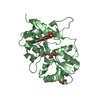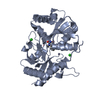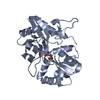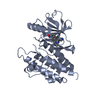[English] 日本語
 Yorodumi
Yorodumi- PDB-4e0w: Crystal structure of the kainate receptor GluK3 ligand binding do... -
+ Open data
Open data
- Basic information
Basic information
| Entry | Database: PDB / ID: 4e0w | ||||||
|---|---|---|---|---|---|---|---|
| Title | Crystal structure of the kainate receptor GluK3 ligand binding domain in complex with kainate | ||||||
 Components Components | Glutamate receptor, ionotropic kainate 3 | ||||||
 Keywords Keywords |  MEMBRANE PROTEIN / MEMBRANE PROTEIN /  ionotropic glutamate receptor / GluK3 / ligand-binding domain / ionotropic glutamate receptor / GluK3 / ligand-binding domain /  agonist agonist | ||||||
| Function / homology |  Function and homology information Function and homology informationPresynaptic function of Kainate receptors / adenylate cyclase inhibiting G protein-coupled glutamate receptor activity / kainate selective glutamate receptor complex / G protein-coupled glutamate receptor signaling pathway / Activation of Ca-permeable Kainate Receptor / negative regulation of synaptic transmission, glutamatergic / glutamate receptor signaling pathway /  glutamate receptor activity / kainate selective glutamate receptor activity / glutamate-gated receptor activity ...Presynaptic function of Kainate receptors / adenylate cyclase inhibiting G protein-coupled glutamate receptor activity / kainate selective glutamate receptor complex / G protein-coupled glutamate receptor signaling pathway / Activation of Ca-permeable Kainate Receptor / negative regulation of synaptic transmission, glutamatergic / glutamate receptor signaling pathway / glutamate receptor activity / kainate selective glutamate receptor activity / glutamate-gated receptor activity ...Presynaptic function of Kainate receptors / adenylate cyclase inhibiting G protein-coupled glutamate receptor activity / kainate selective glutamate receptor complex / G protein-coupled glutamate receptor signaling pathway / Activation of Ca-permeable Kainate Receptor / negative regulation of synaptic transmission, glutamatergic / glutamate receptor signaling pathway /  glutamate receptor activity / kainate selective glutamate receptor activity / glutamate-gated receptor activity / ligand-gated monoatomic ion channel activity involved in regulation of presynaptic membrane potential / dendrite cytoplasm / glutamate receptor activity / kainate selective glutamate receptor activity / glutamate-gated receptor activity / ligand-gated monoatomic ion channel activity involved in regulation of presynaptic membrane potential / dendrite cytoplasm /  synaptic transmission, glutamatergic / synaptic transmission, glutamatergic /  regulation of membrane potential / transmitter-gated monoatomic ion channel activity involved in regulation of postsynaptic membrane potential / postsynaptic density membrane / modulation of chemical synaptic transmission / regulation of membrane potential / transmitter-gated monoatomic ion channel activity involved in regulation of postsynaptic membrane potential / postsynaptic density membrane / modulation of chemical synaptic transmission /  terminal bouton / terminal bouton /  presynaptic membrane / chemical synaptic transmission / presynaptic membrane / chemical synaptic transmission /  perikaryon / perikaryon /  axon / glutamatergic synapse / axon / glutamatergic synapse /  dendrite / dendrite /  plasma membrane plasma membraneSimilarity search - Function | ||||||
| Biological species |   Rattus norvegicus (Norway rat) Rattus norvegicus (Norway rat) | ||||||
| Method |  X-RAY DIFFRACTION / X-RAY DIFFRACTION /  SYNCHROTRON / SYNCHROTRON /  MOLECULAR REPLACEMENT / MOLECULAR REPLACEMENT /  molecular replacement / Resolution: 2.3501 Å molecular replacement / Resolution: 2.3501 Å | ||||||
 Authors Authors | Venskutonyte, R. / Frydenvang, K. / Kastrup, J.S. | ||||||
 Citation Citation |  Journal: Neurochem Int / Year: 2012 Journal: Neurochem Int / Year: 2012Title: Kainate induces various domain closures in AMPA and kainate receptors. Authors: Venskutonyte, R. / Frydenvang, K. / Hald, H. / Rabassa, A.C. / Gajhede, M. / Ahring, P.K. / Kastrup, J.S. #1:  Journal: J.Struct.Biol. / Year: 2011 Journal: J.Struct.Biol. / Year: 2011Title: Binding site and interlobe interactions of the ionotropic glutamate receptor GluK3 ligand binding domain revealed by high resolution crystal structure in complex with (S)-glutamate. Authors: Venskutonyte, R. / Frydenvang, K. / Gajhede, M. / Bunch, L. / Pickering, D.S. / Kastrup, J.S. | ||||||
| History |
|
- Structure visualization
Structure visualization
| Structure viewer | Molecule:  Molmil Molmil Jmol/JSmol Jmol/JSmol |
|---|
- Downloads & links
Downloads & links
- Download
Download
| PDBx/mmCIF format |  4e0w.cif.gz 4e0w.cif.gz | 121.6 KB | Display |  PDBx/mmCIF format PDBx/mmCIF format |
|---|---|---|---|---|
| PDB format |  pdb4e0w.ent.gz pdb4e0w.ent.gz | 94 KB | Display |  PDB format PDB format |
| PDBx/mmJSON format |  4e0w.json.gz 4e0w.json.gz | Tree view |  PDBx/mmJSON format PDBx/mmJSON format | |
| Others |  Other downloads Other downloads |
-Validation report
| Arichive directory |  https://data.pdbj.org/pub/pdb/validation_reports/e0/4e0w https://data.pdbj.org/pub/pdb/validation_reports/e0/4e0w ftp://data.pdbj.org/pub/pdb/validation_reports/e0/4e0w ftp://data.pdbj.org/pub/pdb/validation_reports/e0/4e0w | HTTPS FTP |
|---|
-Related structure data
| Related structure data |  4e0xC  3s9eS S: Starting model for refinement C: citing same article ( |
|---|---|
| Similar structure data |
- Links
Links
- Assembly
Assembly
| Deposited unit | 
| |||||||||
|---|---|---|---|---|---|---|---|---|---|---|
| 1 |
| |||||||||
| Unit cell |
| |||||||||
| Components on special symmetry positions |
| |||||||||
| Details | A tetrameric multimer representing the known biologically significant oligomerization state of the molecule cannot be generated by symmetry within the crystal. |
- Components
Components
| #1: Protein |  / Glutamate receptor 7 / GluR-7 / GluR7 / Glutamate receptor 7 / GluR-7 / GluR7Mass: 29092.453 Da / Num. of mol.: 1 Source method: isolated from a genetically manipulated source Source: (gene. exp.)   Rattus norvegicus (Norway rat) / Gene: Glur7, Grik3 / Plasmid: pOPINJ / Production host: Rattus norvegicus (Norway rat) / Gene: Glur7, Grik3 / Plasmid: pOPINJ / Production host:   Escherichia coli (E. coli) / Strain (production host): Origami 2 / References: UniProt: P42264 Escherichia coli (E. coli) / Strain (production host): Origami 2 / References: UniProt: P42264 | ||||||
|---|---|---|---|---|---|---|---|
| #2: Chemical | ChemComp-KAI /  Kainic acid Kainic acid | ||||||
| #3: Chemical |  Chloride Chloride#4: Chemical | #5: Water | ChemComp-HOH / |  Water WaterSequence details | THE PROTEIN CRYSTALLIZED IS THE EXTRACELLULAR LIGAND BINDING DOMAIN OF GLUK3. TRANSMEMBRANE REGIONS ...THE PROTEIN CRYSTALLIZ | |
-Experimental details
-Experiment
| Experiment | Method:  X-RAY DIFFRACTION / Number of used crystals: 1 X-RAY DIFFRACTION / Number of used crystals: 1 |
|---|
- Sample preparation
Sample preparation
| Crystal | Density Matthews: 2.56 Å3/Da / Density % sol: 52 % |
|---|---|
Crystal grow | Temperature: 293 K / Method: vapor diffusion, hanging drop / pH: 8.2 Details: 1.8 M SODIUM/POTASSIUM PHOSPHATE, CRYSTALS GROWN IN PRESENCE OF GLUTAMATE SOAKED WITH KAINATE, pH 8.2, VAPOR DIFFUSION, HANGING DROP, temperature 293K |
-Data collection
| Diffraction | Mean temperature: 100 K |
|---|---|
| Diffraction source | Source:  SYNCHROTRON / Site: SYNCHROTRON / Site:  ESRF ESRF  / Beamline: ID23-2 / Wavelength: 0.8726 Å / Beamline: ID23-2 / Wavelength: 0.8726 Å |
| Detector | Type: MARMOSAIC 225 mm CCD / Detector: CCD / Date: Jul 26, 2011 |
| Radiation | Protocol: SINGLE WAVELENGTH / Monochromatic (M) / Laue (L): M / Scattering type: x-ray |
| Radiation wavelength | Wavelength : 0.8726 Å / Relative weight: 1 : 0.8726 Å / Relative weight: 1 |
| Reflection | Resolution: 2.35→48.478 Å / Num. all: 13287 / Num. obs: 13274 / % possible obs: 100 % / Redundancy: 7.9 % / Biso Wilson estimate: 36.4 Å2 / Rsym value: 0.075 / Net I/σ(I): 9.7 |
| Reflection shell | Resolution: 2.35→2.48 Å / Redundancy: 8.2 % / Rmerge(I) obs: 0.393 / Mean I/σ(I) obs: 2 / Rsym value: 0.393 / % possible all: 100 |
-Phasing
Phasing | Method:  molecular replacement molecular replacement |
|---|
- Processing
Processing
| Software |
| |||||||||||||||||||||||||||||||||||||||||||||||||||||||||||||||||||||||||||||||||||||||||||||||||||||||||||||||||||||||||||||
|---|---|---|---|---|---|---|---|---|---|---|---|---|---|---|---|---|---|---|---|---|---|---|---|---|---|---|---|---|---|---|---|---|---|---|---|---|---|---|---|---|---|---|---|---|---|---|---|---|---|---|---|---|---|---|---|---|---|---|---|---|---|---|---|---|---|---|---|---|---|---|---|---|---|---|---|---|---|---|---|---|---|---|---|---|---|---|---|---|---|---|---|---|---|---|---|---|---|---|---|---|---|---|---|---|---|---|---|---|---|---|---|---|---|---|---|---|---|---|---|---|---|---|---|---|---|---|
| Refinement | Method to determine structure : :  MOLECULAR REPLACEMENT MOLECULAR REPLACEMENTStarting model: PDB ENTRY 3S9E Resolution: 2.3501→48.478 Å / Occupancy max: 1 / Occupancy min: 0.38 / SU ML: 0.28 / Isotropic thermal model: Isotropic / σ(F): 1.38 / Phase error: 21.05 / Stereochemistry target values: ML Details: RESIDUES 1-4 (GPGT) WERE NOT LOCATED IN THE ELECTRON DENSITY MAP.
| |||||||||||||||||||||||||||||||||||||||||||||||||||||||||||||||||||||||||||||||||||||||||||||||||||||||||||||||||||||||||||||
| Solvent computation | Shrinkage radii: 0.98 Å / VDW probe radii: 1.2 Å / Solvent model: FLAT BULK SOLVENT MODEL / Bsol: 45.155 Å2 / ksol: 0.378 e/Å3 | |||||||||||||||||||||||||||||||||||||||||||||||||||||||||||||||||||||||||||||||||||||||||||||||||||||||||||||||||||||||||||||
| Displacement parameters | Biso mean: 41.9 Å2
| |||||||||||||||||||||||||||||||||||||||||||||||||||||||||||||||||||||||||||||||||||||||||||||||||||||||||||||||||||||||||||||
| Refinement step | Cycle: LAST / Resolution: 2.3501→48.478 Å
| |||||||||||||||||||||||||||||||||||||||||||||||||||||||||||||||||||||||||||||||||||||||||||||||||||||||||||||||||||||||||||||
| Refine LS restraints |
| |||||||||||||||||||||||||||||||||||||||||||||||||||||||||||||||||||||||||||||||||||||||||||||||||||||||||||||||||||||||||||||
| LS refinement shell |
| |||||||||||||||||||||||||||||||||||||||||||||||||||||||||||||||||||||||||||||||||||||||||||||||||||||||||||||||||||||||||||||
| Refinement TLS params. | Method: refined / Refine-ID: X-RAY DIFFRACTION
| |||||||||||||||||||||||||||||||||||||||||||||||||||||||||||||||||||||||||||||||||||||||||||||||||||||||||||||||||||||||||||||
| Refinement TLS group |
|
 Movie
Movie Controller
Controller












 PDBj
PDBj








